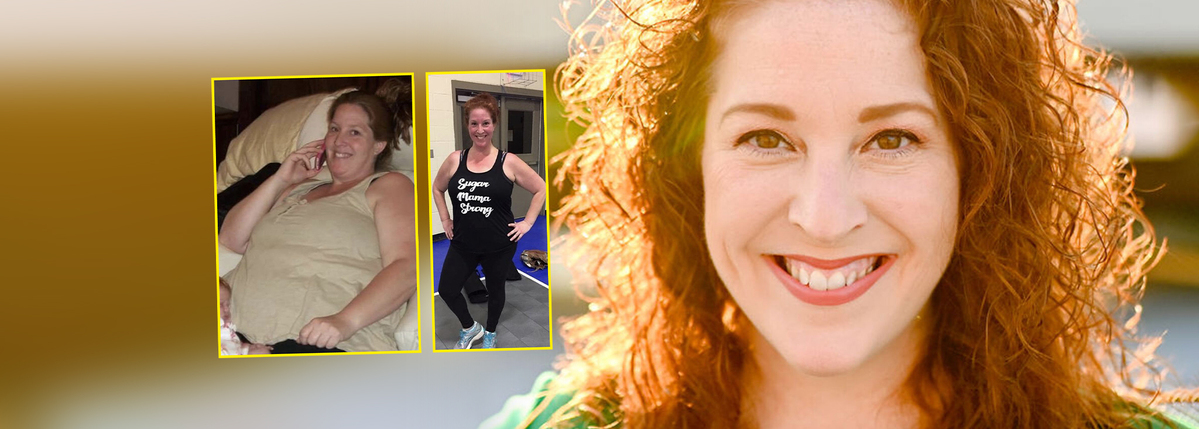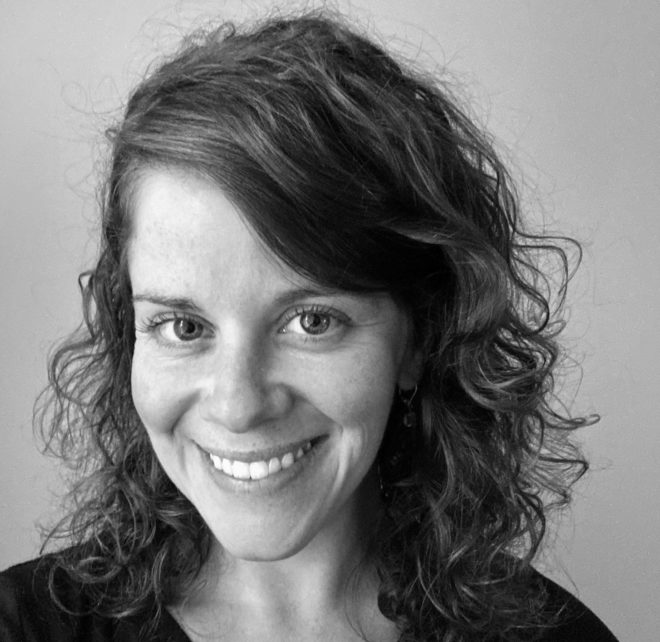Losing Weight with Type 2 Diabetes: “You cannot hate yourself to wellness.”
When Mary Van Doorn was diagnosed with type 2 diabetes at 21 years old—after a routine physical—she didn’t take the diagnosis very seriously.
“I made zero effort to change my life at that point,” recalls Van Doorn. Over 20 years later, she’s now a diabetes and wellness coach at Sugar Mama Strong Fitness & Wellness and founder of the ever-growing Sugar Mama Strong Support Group for women with diabetes on Facebook.
“You feel invincible when you’re young,” says Van Doorn of her young diagnosis. “And I didn’t actually feel sick, so it went in one ear and out the other.”
There’s a strong genetic component for type 2 diabetes in both sides of Van Doorn’s family.
“We didn’t talk about diabetes as a family. My mother was always on a diet, and my father—who was very thin—ate whatever he wanted,” says Van Doorn. “I’ve been battling my weight since my teens. I was always the biggest of my friends, wearing a size 14 or 16 in high school.”
Habits of emotional eating and binge-eating began in her teens, too.
“If I wasn’t so active in high school, I would’ve gotten up to 300 pounds with how much binge-eating I was doing,” says Van Doorn. “I started dieting when I was around 15, during the fat-free dieting era. I remember eating only Special K cereal and Lender’s Bagels with fat-free cream cheese. I lost 15 or 20 pounds, got down to a size 10/12—which was small for me. But of course, I eventually gained it back.”
Facing my diagnosis at age 25
Eventually starting several types of diabetes medications, Van Doorn says she rarely checked her blood sugar and took her medications inconsistently. It wasn’t until she wanted to have a baby that she decided to take her diagnosis seriously.
“My first pregnancy, I found out at 16 weeks that the baby’s brain hadn’t formed correctly. Unfortunately, we lost the baby.”
In preparation for another pregnancy, Van Doorn says she asked her healthcare team to start using insulin to manage her blood sugars instead of non-insulin diabetes medications—in an effort to reduce the risk of complications.
“I knew this child’s life depended on my actions,” recalls Van Doorn. “So I was much more willing to do what it takes. I pricked my finger five times a day, I wrote my numbers down and brought the logbook to my appointments. I was open with my healthcare team, I talked to them.”
Van Doorn also used insulin to manage her diabetes during her second pregnancy. She continued on insulin until her second child was no longer breastfeeding, and then returned to taking other non-insulin diabetes medications.
Exercising and losing weight—why is my A1c still 11 percent?
“By the time my second child was five years old, I was teaching fitness classes six times a week, running half-marathons and had lost 100 pounds,” explains Van Doorn. “But I had a really scary doctor’s appointment when the doctor said my A1c was 11 percent.”
Despite her grueling and intense exercise schedule, Van Doorn says was still binge-eating junk food regularly, taking her medications inconsistently and never checking her blood sugar.
Back when she was a member of Weight Watchers, Van Doorn remembers using her abundance of extra points earned through exercise on junk food.
“Weight Watchers wasn’t telling me to spend those points on Krispy Kreme.”
“My doctor was so concerned about my overall health, she said she was afraid I might have a heart attack…I was shocked,” recalls Van Doorn. “I was only focused on my appearance, not my actual overall wellness.”
While she knows type 2 diabetes is a gradual disease—and insulin production gradually decreases over time for many—Van Doorn says she makes a point not to beat herself for the years she spent in denial.
“I can’t rewind the years of denial I went through and did nothing,” she says. “But I don’t want to die at a young age.”
Facing the habit of binge-eating and emotional eating
“I had to find my why,” says Van Doorn. “Why is losing weight and getting my A1c down important to me?”
A self-proclaimed perfectionist in nearly every other part of her life, that level of sharp discipline has never worked well in the approach to wellness. Instead, she had to face her biggest obstacles and find her true motivation. Fortunately, these two keys to her long-term wellness are closely related.
“My why? My real motivation? I never want my kids to think that I chose food over them,” says Van Doorn.
“I never want my kids to think I chose to eat another tray of brownies, slowly killing myself with food, instead of choosing to be healthier so I can be there for them. I would never want my kids to feel like I could’ve done more, could’ve tried harder to be in their life longer.”
After decades of binge-eating and using food to cope with stress, Van Doorn faced this habit fully for the first time.
“I had to get to the bottom of my own bullshit,” she says. “That was a turning point for me.”
Van Doorn says she finally learned how to confront the emotion, stress, or impulse she was feeling that was driving frequent binge-eating.
“Nobody wants to do it. We’d rather try every diet in the world and pay for every gym membership than actually talk about why we are binge-eating,” says Van Doorn.
Learning to let yourself actually feel that emotion—truly feel it—and then let it go is critical. Van Doorn says she had to learn that she can feel emotion without letting it define her entire day or character.
“Because food is not going to fix what it is that you’re feeling. You can try to bury those feelings with food but then you know you’re just gonna feel crap, your blood sugar will be over 400 mg/dL, then you feel guilty and after all that food, you don’t feel any better.”
That impulse to eat doesn’t necessarily go away, either—even after years of learning not to indulge it.
“I’m still not completely past it,” says Van Doorn. “I think about it every day. I feel that urge to binge every day. I started thinking about ordering a big breakfast at Burger King after dropping my daughter off at school the other morning. But then my husband joined us for the drive, so I knew there’s no way I’d be tempted to do that with him in the car.”
Van Doorn says there’s a split-second moment where you have that first thought of binge-eating when you have an opportunity to ask yourself, “Okay, what am I feeling right now that’s making me want to eat? What am I feeling? What do I actually need?”
Just keep going…
Today, Van Doorn gets up at 5 a.m. to make sure she gets her daily dose of exercise—during the part of the day when she knows no one will need anything from her. To help enforce her own exercise goals, Van Doorn meets with a group of current and former coaching clients every morning on Zoom.
“We don’t do the actual workout together, but we all log online at the same time to hold each other accountable. If someone is even a few minutes late, we’re texting them to see if they’re coming,” says Van Doorn.
Personally, she’s made peace with the fact that despite all the work she’s done to lose weight and improve her nutrition, her body still needs diabetes medications to help her maintain healthy blood sugar levels.
“It’s such a common goal—to get off your type 2 diabetes meds—but we know this is a progressive disease, so that might not be possible for everybody. It’s okay,” says Van Doorn.“I’ve done all the things that should help me get off my meds, and I still need them.”
“Actually, I recently started taking a small dose of long-acting insulin because out of nowhere my blood sugar just started spiking overnight. Nothing in my diet, my weight, my exercise routine has changed. It’s okay.”
Through her wellness coaching, Van Doorn helps her clients learn how to create a relationship with food they can truly sustain for years. It doesn’t have to be perfect, it should include less-than-perfect treats to prevent feeling deprived and it all comes from wanting to treat yourself well.
“You cannot hate yourself to wellness,” says Van Doorn. “You have to love yourself there.”
“Punishing yourself by going on an extreme or super-restrictive diet, or spending hours in the gym because you’re angry at the state of your health, will never yield long-term improvements. Make positive choices because you want to be kind to yourself and because you’re worth the effort.”
And don’t forget, it all starts with figuring out why your health goals matter to you.
“My son recently gave me a note that said, ‘Just keep going’,” says Van Doorn. “That’s why I get up at 5 o’clock in the morning. He’s watching me change my life.”
Educational content related to weight loss and A1c is made possible with support from Lilly Diabetes. Editorial control rests solely on Beyond Type 2.





